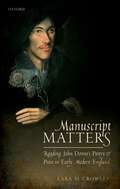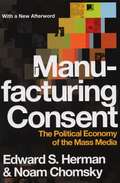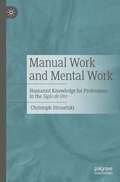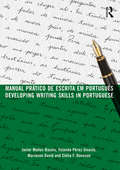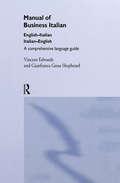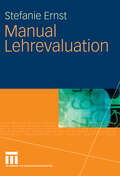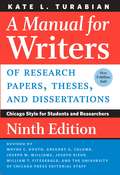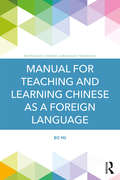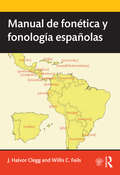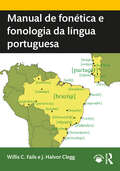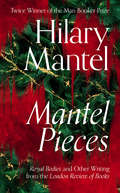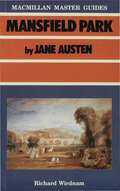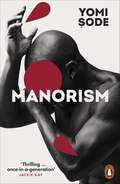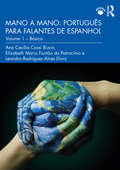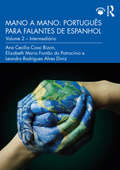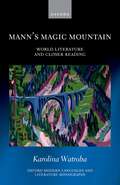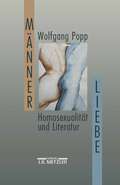- Table View
- List View
Manuscript Matters: Reading John Donne's Poetry and Prose in Early Modern England
by Lara M. CrowleyManuscript Matters illuminates responses to some of John Donne's most elusive texts by his contemporary audiences. Since examples of seventeenth-century literary criticism prove somewhat rare and frequently ambiguous, this book emphasizes a critical framework rarely used for exhibiting early readers' exegeses of literary texts: the complete manuscripts containing them. Many literary manuscripts that include poems by Donne and his contemporaries were compiled during their lifetimes, often by members of their circles. For this reason, and because various early modern poems and prose works satirize topical events and prominent figures in highly coded language, attempting to understand early literary interpretations proves challenging but highly valuable. Compilers, scribes, owners, and other readers–men and women who shared in Donne's political, religious, and social contexts–offer clues to their literary responses within a range of features related to the construction and subsequent use of the manuscripts. This study's findings call us to investigate more extensively and systematically how certain early manuscripts were constructed through analysis of such features as scripts, titles, sequence of contents, ascriptions, and variant diction. While such studies can throw light on many early modern texts, exploring artefacts containing Donne's works proves particularly useful because more of his poetry circulated in manuscript than did that of any other early modern poet. Manuscript Matters engages Donne's satiric, lyric, and religious poetry, as well as his prose paradoxes and problems. Analysing his texts within their manuscript contexts enables modern readers to interpret Donne's poetry and prose through an early modern lens.
Manufacturing Consent: The Political Economy of the Mass Media
by Noam Chomsky Edward S HermanWe normally think that the press are cantankerous, obstinate, and ubiquitous in its search for truth. In Manufacturing Consent Edward Herman and Noam Chomsky show how an underlying elite consensus largely structures all facets of the news. Far from challenging established power, the media work hard to discover and mirror its assumptions. The authors skilfully dissect the way in which the marketplace and the economics of publishing significantly shape the news. They reveal how issues are framed and topics chosen, and contrast the double standards underlying accounts of free elections, a free press, and governmental repression. The authors conclude that the modern mass media can best be understood in terms of a 'propaganda model'. News and entertainment companies dedicate themselves to profit within the established system. Their interests require that they support the governing assumptions of state and private power. The propaganda model provokes outrage from journalists, editors and broadcasters, but twenty years after first publication, Manufacturing Consent remains the most important critique of the mass media.
Manual Work and Mental Work: Humanist Knowledge for Professions in the Siglo de Oro
by Christoph StrosetzkiInformation Text: In the early modern period, numerous texts deal with professions by presenting the knowledge required in each case, individual fields of activity, purpose, origin and prestige. The course of argumentation is humanistic, insofar as it mostly starts from the human being. The ancient idea of the primacy of mental work over manual work is formative here. The importance of Spain results from the fact that the Spanish king Charles V was both emperor and ruler of the colonies in America, i.e. he ruled a world empire by the standards of the time. After discussing some central categories, overall representations of knowledge, professions, and prominent professional representatives are presented. Here, the hierarchization and its relativization by satire is revealing. The mechanical arts and the artes liberales are then presented on the basis of individual professions selected as characteristic examples, each with its own specific knowledge. The higher faculties of medicine, theology and jurisprudence with their representatives form the conclusion.
Manual prático de escrita em português: Developing Writing Skills in Portuguese (Developing Writing Skills)
by Javier Muñoz-Basols Yolanda Pérez Sinusía Marianne David Clélia F. DonovanManual prático de escrita em português/Developing Writing Skills in Portuguese provides intermediate- and advanced-level students with the necessary skills to become competent and confident writers in the Portuguese language. With a focus on writing as a craft, Manual prático de escrita em português offers a rich selection of original materials including narrative texts, expository essays, opinion pieces and newspaper articles. Each chapter covers a specific kind of writing and is designed to help tackle the material in small units. The book aids students in crafting clear, coherent and cohesive texts by means of guided practice and step-by-step activities. Suitable for use as a classroom text or as a self-study course, this book is ideal for students at level B2 – C2 of the Common European Framework for Languages or at Intermediate High – Advanced High on the ACTFL proficiency scales.
Manual prático de escrita em português: Developing Writing Skills in Portuguese (Developing Writing Skills)
by Javier Muñoz-Basols Yolanda Pérez Sinusía Marianne David Clélia F. DonovanManual prático de escrita em português/Developing Writing Skills in Portuguese provides intermediate- and advanced-level students with the necessary skills to become competent and confident writers in the Portuguese language. With a focus on writing as a craft, Manual prático de escrita em português offers a rich selection of original materials including narrative texts, expository essays, opinion pieces and newspaper articles. Each chapter covers a specific kind of writing and is designed to help tackle the material in small units. The book aids students in crafting clear, coherent and cohesive texts by means of guided practice and step-by-step activities. Suitable for use as a classroom text or as a self-study course, this book is ideal for students at level B2 – C2 of the Common European Framework for Languages or at Intermediate High – Advanced High on the ACTFL proficiency scales.
Manual of Business Italian: A Comprehensive Language Guide
by Vincent Edwards Gianfranca Gessa ShepheardManual of Business Italian is the most comprehensive, single-volume reference handbook for students and professionals using Italian.Designed for all users, no matter what level of language skill, this manual comprises five parts: * A 6000-word, two-way Glossary of the most useful business terms * A 100-page Written Communications section giving models of 50 letters, faxes and documents * An 80-page Spoken Situations section covering face-to-face and telephone situations * A short Reference Grammar outlining the major grammar features of Italian * A short Business Facts section covering essential information of the country or countries where Italian is used Written by an experienced native and non-native speaker team, this unique volume is an essential, one-stop reference for all students and professionals studying or working in business and management where Italian is used
Manual of Business Italian: A Comprehensive Language Guide
by Vincent Edwards Gianfranca Gessa ShepheardManual of Business Italian is the most comprehensive, single-volume reference handbook for students and professionals using Italian.Designed for all users, no matter what level of language skill, this manual comprises five parts: * A 6000-word, two-way Glossary of the most useful business terms * A 100-page Written Communications section giving models of 50 letters, faxes and documents * An 80-page Spoken Situations section covering face-to-face and telephone situations * A short Reference Grammar outlining the major grammar features of Italian * A short Business Facts section covering essential information of the country or countries where Italian is used Written by an experienced native and non-native speaker team, this unique volume is an essential, one-stop reference for all students and professionals studying or working in business and management where Italian is used
Manual Lehrevaluation
by Stefanie ErnstDas "Manual Lehrevaluation" bietet einen kompakten und gut nachvollziehbaren Einstieg in die Praxis der Evaluation im Hochschulbereich und leistet damit einen wichtigen Beitrag zu Qualitätssicherung und Qualitätsverbesserung in der Lehre.
A Manual for Writers of Research Papers, Theses, and Dissertations, Ninth Edition: Chicago Style for Students and Researchers (Chicago Guides to Writing, Editing, and Publishing)
by Kate L. TurabianWhen Kate L. Turabian first put her famous guidelines to paper, she could hardly have imagined the world in which today’s students would be conducting research. Yet while the ways in which we research and compose papers may have changed, the fundamentals remain the same: writers need to have a strong research question, construct an evidence-based argument, cite their sources, and structure their work in a logical way. A Manual for Writers of Research Papers, Theses, and Dissertations—also known as “Turabian”—remains one of the most popular books for writers because of its timeless focus on achieving these goals. This new edition filters decades of expertise into modern standards. While previous editions incorporated digital forms of research and writing, this edition goes even further to build information literacy, recognizing that most students will be doing their work largely or entirely online and on screens. Chapters include updated advice on finding, evaluating, and citing a wide range of digital sources and also recognize the evolving use of software for citation management, graphics, and paper format and submission. The ninth edition is fully aligned with the recently released Chicago Manual of Style, 17th edition, as well as with the latest edition of The Craft of Research. Teachers and users of the previous editions will recognize the familiar three-part structure. Part 1 covers every step of the research and writing process, including drafting and revising. Part 2 offers a comprehensive guide to Chicago’s two methods of source citation: notes-bibliography and author-date. Part 3 gets into matters of editorial style and the correct way to present quotations and visual material. A Manual for Writers also covers an issue familiar to writers of all levels: how to conquer the fear of tackling a major writing project. Through eight decades and millions of copies, A Manual for Writers has helped generations shape their ideas into compelling research papers. This new edition will continue to be the gold standard for college and graduate students in virtually all academic disciplines.
Manual for Teaching and Learning Chinese as a Foreign Language (Routledge Chinese Language Pedagogy)
by Bo HuWritten in an extended dictionary format, the Manual for Teaching and Learning Chinese as a Foreign Language aims to cover all key terms related to teaching Chinese as a foreign language. Each section contains an introduction with language-specific information, and identifies students and teachers’ common questions, including the capacity of Chinese as a morphologically unmarked language to indicate categories such as tense and mood. Many entries listed in this manual come with an explanation, a commentary, and rich examples. The Manual for Teaching and Learning Chinese as a Foreign Language appeals to both Chinese as a foreign language (CFL) teachers and students, as well as being the ideal reference for researchers conducting comparative studies of the Chinese and English languages.
Manual for Teaching and Learning Chinese as a Foreign Language (Routledge Chinese Language Pedagogy)
by Bo HuWritten in an extended dictionary format, the Manual for Teaching and Learning Chinese as a Foreign Language aims to cover all key terms related to teaching Chinese as a foreign language. Each section contains an introduction with language-specific information, and identifies students and teachers’ common questions, including the capacity of Chinese as a morphologically unmarked language to indicate categories such as tense and mood. Many entries listed in this manual come with an explanation, a commentary, and rich examples. The Manual for Teaching and Learning Chinese as a Foreign Language appeals to both Chinese as a foreign language (CFL) teachers and students, as well as being the ideal reference for researchers conducting comparative studies of the Chinese and English languages.
Manual de fonética y fonología españolas
by J. Halvor Clegg Willis C. FailsWritten entirely in Spanish, Manual de fonética y fonología españolas has a comprehensive scope that touches on all aspects of phonetics and phonology—including acoustic and auditory phonetics, phonotactics, and suprasegmentals, which most often remain untreated. The book provides students with a detailed and accurate yet accessible introduction to Spanish phonetics and phonology. It includes introductory chapters which place these disciplines within the general field of linguistics and which emphasize the role of sounds and their representation in human communication. Key features: Written by trained phoneticians and informed by the current science of phonetics. No prior knowledge of linguistics assumed, as a foundation is laid throughout for all linguistic terms and concepts. Each chapter contains a summary, a list of concepts and terminology, review questions, and pedagogically relevant pronunciation exercises keyed to the specific hints and suggestions provided in the chapters. Chapters dealing with the physical production of sounds contain sections with “Pedagogical Hints,” “Practical Suggestions,” and “Pronunciation Exercises” to link theory to the practical aspects of improving pronunciation. A wealth of graphic material to illustrate each concept clearly. Models of how to pronounce the sounds, sentences and exercises presented in the text, are available online at routledge.com/cw/clegg. Manual de fonética y fonología españolas is a comprehensive introduction designed to be clear and accessible to advanced students of Spanish to help them understand how to improve their pronunciation. It will serve as an excellent book for graduate students as well as a valuable resource for teachers, linguists and language professionals.
Manual de fonética y fonología españolas
by J. Halvor Clegg Willis C. FailsWritten entirely in Spanish, Manual de fonética y fonología españolas has a comprehensive scope that touches on all aspects of phonetics and phonology—including acoustic and auditory phonetics, phonotactics, and suprasegmentals, which most often remain untreated. The book provides students with a detailed and accurate yet accessible introduction to Spanish phonetics and phonology. It includes introductory chapters which place these disciplines within the general field of linguistics and which emphasize the role of sounds and their representation in human communication. Key features: Written by trained phoneticians and informed by the current science of phonetics. No prior knowledge of linguistics assumed, as a foundation is laid throughout for all linguistic terms and concepts. Each chapter contains a summary, a list of concepts and terminology, review questions, and pedagogically relevant pronunciation exercises keyed to the specific hints and suggestions provided in the chapters. Chapters dealing with the physical production of sounds contain sections with “Pedagogical Hints,” “Practical Suggestions,” and “Pronunciation Exercises” to link theory to the practical aspects of improving pronunciation. A wealth of graphic material to illustrate each concept clearly. Models of how to pronounce the sounds, sentences and exercises presented in the text, are available online at routledge.com/cw/clegg. Manual de fonética y fonología españolas is a comprehensive introduction designed to be clear and accessible to advanced students of Spanish to help them understand how to improve their pronunciation. It will serve as an excellent book for graduate students as well as a valuable resource for teachers, linguists and language professionals.
Manual de fonética e fonologia da língua portuguesa
by J. Halvor Clegg Willis C. FailsEscrito inteiramente em português, o Manual de fonética e fonologia da língua portuguesa é uma obra que abrange todos os aspectos fonéticos e fonológicos desse idioma, inclusive as questões de fonética acústica e auditiva, fonotática e traços suprassegmentais, que a maioria dos livros didáticos não aborda. Neste livro, o estudante encontrará uma introdução detalhada e exata, mas acessível, à fonética e à fonologia da língua portuguesa. Inclui capítulos introdutórios que contextualizam essas disciplinas no campo geral da linguística e salientam o papel dos sons e sua representação na comunicação humana. Principais características: ● Escrito por fonetistas qualificados e versados nas questões atuais da ciência fonética. ● Não é preciso já saber linguística, pois o livro expõe todos os termos e conceitos linguísticos necessários. ● Cada capítulo conta com um resumo, uma lista de conceitos e termos, perguntas de revisão e exercícios de pronúncia relevantes destinados à prática dos conselhos e sugestões específicos do capítulo. ● Os capítulos que abordam a produção física dos sons contêm seções de "Dicas Pedagógicas", "Conselhos Práticos" e "Exercícios de Pronúncia" que ligam a teoria aos aspectos práticos da boa pronúncia. ● Uma característica exclusiva deste livro é a exposição da fonética e fonologia das três principais normas cultas da língua portuguesa: a de São Paulo e do Rio de Janeiro para o português brasileiro (PB), e a de Lisboa para o português europeu (PE). ● Numerosas imagens, gráficos e tabelas para ilustrar claramente cada conceito. ● Recursos eletrônicos, disponíveis online nos materiais de eResource, com a pronúncia dos sons, frases e exercícios do livro. O Manual de fonética e fonologia da língua portuguesa é uma introdução abrangente a esses campos, escrita de modo a ser clara e acessível aos estudantes de português em nível avançado, para ajudá-los a entender como melhorar a própria pronúncia. O livro é excelente também tanto para alunos de pós-graduação, como para professores, linguistas e profissionais de letras. Written entirely in Portuguese, Manual de fonética e fonologia da língua portuguesa presents an accurate yet accessible introduction to Portuguese phonetics and phonology. The book covers all phonetic and phonological aspects of the language, including those often missing from other textbooks, such as acoustic and auditory phonetics, phonotactics, and suprasegmentals. The book maintains a careful balance between the theoretical and practical aspects of the topic and is designed to help learners improve their pronunciation through an understanding of the linguistic principles of phonetics and phonology combined with the application of these principles through exercises and practice. Additional pronunciation resources are available online at www.routledge.com/9780367179915. Written in a clear and accessible manner, the book is ideal for advanced students of Portuguese with no prior knowledge of linguistics.
Mantel Pieces: Royal Bodies And Other Writing From The London Review Of Books
by Hilary MantelA stunning collection of essays and memoir from twice Booker Prize winner and international bestseller Hilary Mantel, author of The Mirror and the Light
Mansfield Park by Jane Austen (Bloomsbury Master Guides)
by Richard WirdnamThis ebook is now available from Bloomsbury Academic. Bloomsbury Academic publish acclaimed resources for undergraduate and postgraduate courses across a broad range of subjects including Art & Visual Culture, Biblical Studies, Business & Management, Drama & Performance Studies, Economics, Education, Film & Media, History, Linguistics, Literary Studies, Philosophy, Politics & International Relations, Religious Studies, Social Work & Social Welfare, Study Skills and Theology. Visit bloomsbury.com for more information.
Manorism
by Yomi SodeSHORTLISTED FOR THE 2022 T. S. ELIOT PRIZESHORTLISTED FOR THE 2023 RATHBONES FOLIO PRIZEA GUARDIAN AND FINANCIAL TIMES BOOK OF THE YEAR 'A wonder of a collection' Caleb Azumah Nelson'Thrilling ... once-in-a-generation' Jackie Kay'Genius ... tells a thousand stories in stunningly crafted verse' Nikita Gill'Remarkable, textured ... Yomi Sode is a beautiful storyteller' Candice Carty-Williams'Heartbreaking ... This debut is the living heart and soul of contemporary poetry' Pascale Petit'Vivid, beautiful and deeply moving' Rt Hon Diane Abbott MP'Yomi Sode writes with clarity, anger and love' Andrew Graham-Dixon'Searing, shimmering, brilliant' Yrsa Daley-Ward'A must for all lovers of poetry and its power' Roger Robinson'Manorism is a classic' Caleb FemiImpassioned, insightful, electric, Manorism is a poetic examination of the lives of Black British men and boys: propped up and hemmed in by contemporary masculinity, deepened by family, misrepresented in the media, and complicated by the riches, and the costs, of belonging and inheritance. It is also an exploration of the differences of impunity afforded to white and Black people, and to white and Black artists.Caravaggio - originally, unexpectedly - looms large: as a man who moved between spheres of exalted patronage and petty criminality; as a painter who, amid the elegant conventions of late Mannerism, forged his own style of visceral dark and light; and as an individual whose recognized genius was allowed to legitimate and excuse his violence.In this profound and moving debut, Yomi Sode asks: what does it mean to find oneself between worlds - to 'code-switch', adapting one's speech and manners to widely differing cultural contexts? Who is, and who isn't, allowed to be more than their origins? And what do we owe each other? What do we owe ourselves?
The Manor House
by Jane Holland'I absolutely love this book from start to finish...a really atmospheric read, and brilliant characters.' NetGalley Reader, *****1963. When Eleanor meets famous young poet, Lyndon Chance, he offers a way to flee her abusive father. In return, she must pretend to be Lyndon's wife. He takes her home to a Tudor manor on the Camel Estuary in Cornwall, where she finds herself in the middle of a feud between Lyndon and his twin brother, Oliver. It's soon clear that the old house hides many dark secrets. But could they be a threat to Eleanor?Now. Taylor has come to idyllic Cornwall to research for her Master's thesis, combining her love for conservation with a personal interest in Chance's poetry. Haunted by her own tragic past, Taylor finds Chance's notoriety fascinating. If only the poet's grandson, Julius, wasn't so determined to thwart her attempts to uncover his family secrets. As Eleanor realises she's out of her depth at Estuary House, drawn to Lyndon like a moth to a flame, Taylor and Julius must fight their own attraction - but could shadows from the past tear them all apart?A stunning and richly evocative timeslip, perfect for fans of Lucinda Riley, Santa Montefiore and Kate Morton.
Mano a Mano: Volume 1 – Básico (Mano a mano: português para falantes de espanhol)
by Ana Cecília Cossi Bizon Elizabeth Maria Fontão do Patrocínio Leandro Rodrigues Alves DinizMano a Mano: Português para Falantes de Espanhol vem preencher uma importante lacuna no mercado editorial: a carência de livros didáticos que, considerando as necessidades específicas de falantes de espanhol, favoreçam um desenvolvimento mais rápido de sua proficiência em português. A coleção reúne uma série de características favoráveis à aprendizagem do português em diferentes contextos (ensino médio, universidades, cursos livres): Convida o(a) aluno(a) a desenvolver sua proficiência em português ao mesmo tempo que forma uma imagem multifacetada do Brasil, em diálogo com suas próprias construções culturais, desconstruindo discursos estabilizados e ampliando seus horizontes; Favorece o trânsito por múltiplas práticas de letramento, em que circulam diferentes gêneros discursivos, oferecendo oportunidades para que o(a) estudante aprimore suas capacidades de linguagem em contextos reais, ou próximos a situações autênticas de interação; Sensibiliza o(a) aluno(a) para diferentes variedades da língua portuguesa; Permite ao(à) estudante desenvolver suas capacidades léxico-gramaticais e fonético-fonológicas de maneira reflexiva e contextualizada, levando em consideração necessidades específicas de falantes de espanhol; Propõe tarefas semelhantes às encontradas no Certificado de Proficiência em Língua Portuguesa para Estrangeiros (Celpe-Bras), do Ministério da Educação brasileiro; É acompanhado por dois cadernos complementares integrados, com explicações detalhadas referentes a recursos léxico-gramaticais e fonético-fonológicos, além de uma série de atividades; Disponibiliza online os vídeos e áudios de tarefas de compreensão oral e de atividades de pronúncia. Preparado para o desenvolvimento de um curso de até 60 horas em contexto de imersão, ou 90 horas de não-imersão, Mano a Mano, Volume 1 – Básico permite levar falantes de espanhol (como língua materna ou estrangeira/adicional) que nunca tiveram contato significativo prévio com o português até o início do nível Intermediário do Celpe-Bras, do B1 do Quadro Europeu Comum de Referência para as Línguas, ou do Intermediário Médio do American Council on the Teaching of Foreign Languages.
Mano a Mano: Volume 1 – Básico (Mano a mano: português para falantes de espanhol)
by Ana Cecília Cossi Bizon Elizabeth Maria Fontão do Patrocínio Leandro Rodrigues Alves DinizMano a Mano: Português para Falantes de Espanhol vem preencher uma importante lacuna no mercado editorial: a carência de livros didáticos que, considerando as necessidades específicas de falantes de espanhol, favoreçam um desenvolvimento mais rápido de sua proficiência em português. A coleção reúne uma série de características favoráveis à aprendizagem do português em diferentes contextos (ensino médio, universidades, cursos livres): Convida o(a) aluno(a) a desenvolver sua proficiência em português ao mesmo tempo que forma uma imagem multifacetada do Brasil, em diálogo com suas próprias construções culturais, desconstruindo discursos estabilizados e ampliando seus horizontes; Favorece o trânsito por múltiplas práticas de letramento, em que circulam diferentes gêneros discursivos, oferecendo oportunidades para que o(a) estudante aprimore suas capacidades de linguagem em contextos reais, ou próximos a situações autênticas de interação; Sensibiliza o(a) aluno(a) para diferentes variedades da língua portuguesa; Permite ao(à) estudante desenvolver suas capacidades léxico-gramaticais e fonético-fonológicas de maneira reflexiva e contextualizada, levando em consideração necessidades específicas de falantes de espanhol; Propõe tarefas semelhantes às encontradas no Certificado de Proficiência em Língua Portuguesa para Estrangeiros (Celpe-Bras), do Ministério da Educação brasileiro; É acompanhado por dois cadernos complementares integrados, com explicações detalhadas referentes a recursos léxico-gramaticais e fonético-fonológicos, além de uma série de atividades; Disponibiliza online os vídeos e áudios de tarefas de compreensão oral e de atividades de pronúncia. Preparado para o desenvolvimento de um curso de até 60 horas em contexto de imersão, ou 90 horas de não-imersão, Mano a Mano, Volume 1 – Básico permite levar falantes de espanhol (como língua materna ou estrangeira/adicional) que nunca tiveram contato significativo prévio com o português até o início do nível Intermediário do Celpe-Bras, do B1 do Quadro Europeu Comum de Referência para as Línguas, ou do Intermediário Médio do American Council on the Teaching of Foreign Languages.
Mano a Mano: Volume 2 – Intermediário (Mano a mano: português para falantes de espanhol)
by Ana Cecília Cossi Bizon Elizabeth Maria Fontão do Patrocínio Leandro Rodrigues Alves DinizMano a Mano: Português para Falantes de Espanhol vem preencher uma importante lacuna no mercado editorial: a carência de livros didáticos que, considerando as necessidades específicas de falantes de espanhol, favoreçam um desenvolvimento mais rápido de sua proficiência em português. A coleção reúne uma série de características favoráveis à aprendizagem do português em diferentes contextos (ensino médio, universidades, cursos livres): Convida o(a) aluno(a) a desenvolver sua proficiência em português ao mesmo tempo em que forma uma imagem multifacetada do Brasil, em diálogo com suas próprias construções culturais, desconstruindo discursos estabilizados e ampliando seus horizontes; Favorece o trânsito por múltiplas práticas de letramento, em que circulam diferentes gêneros discursivos, oferecendo oportunidades para que o(a) estudante aprimore suas capacidades de linguagem em contextos reais, ou próximos a situações autênticas de interação; Sensibiliza o(a) aluno(a) para diferentes variedades da língua portuguesa; Permite ao(à) estudante desenvolver suas capacidades léxico-gramaticais e fonético-fonológicas de maneira reflexiva e contextualizada, levando em consideração necessidades específicas de falantes de espanhol; Propõe tarefas semelhantes às encontradas no Certificado de Proficiência em Língua Portuguesa para Estrangeiros (Celpe-Bras), do Ministério da Educação brasileiro; É acompanhado por dois cadernos complementares integrados, com explicações detalhadas referentes a recursos léxico-gramaticais e fonético-fonológicos, além de uma série de atividades; Disponibiliza online os vídeos e áudios de tarefas de compreensão oral e de atividades de pronúncia. Preparado para o desenvolvimento de um curso de até 60 horas em contexto de imersão, ou 90 horas em contexto de não-imersão, Mano a Mano, Volume 2 – Intermediário permite levar falantes de espanhol (como língua materna ou estrangeira/adicional) do início do Intermediário Superior do Celpe-Bras, do início do B1 ao início do B2 do Quadro Europeu Comum de Referência para as Línguas, ou do início do Intermediário Médio ao início do Avançado Médio na escala do American Council on the Teaching of Foreign Languages.
Mano a Mano: Volume 2 – Intermediário (Mano a mano: português para falantes de espanhol)
by Ana Cecília Cossi Bizon Elizabeth Maria Fontão do Patrocínio Leandro Rodrigues Alves DinizMano a Mano: Português para Falantes de Espanhol vem preencher uma importante lacuna no mercado editorial: a carência de livros didáticos que, considerando as necessidades específicas de falantes de espanhol, favoreçam um desenvolvimento mais rápido de sua proficiência em português. A coleção reúne uma série de características favoráveis à aprendizagem do português em diferentes contextos (ensino médio, universidades, cursos livres): Convida o(a) aluno(a) a desenvolver sua proficiência em português ao mesmo tempo em que forma uma imagem multifacetada do Brasil, em diálogo com suas próprias construções culturais, desconstruindo discursos estabilizados e ampliando seus horizontes; Favorece o trânsito por múltiplas práticas de letramento, em que circulam diferentes gêneros discursivos, oferecendo oportunidades para que o(a) estudante aprimore suas capacidades de linguagem em contextos reais, ou próximos a situações autênticas de interação; Sensibiliza o(a) aluno(a) para diferentes variedades da língua portuguesa; Permite ao(à) estudante desenvolver suas capacidades léxico-gramaticais e fonético-fonológicas de maneira reflexiva e contextualizada, levando em consideração necessidades específicas de falantes de espanhol; Propõe tarefas semelhantes às encontradas no Certificado de Proficiência em Língua Portuguesa para Estrangeiros (Celpe-Bras), do Ministério da Educação brasileiro; É acompanhado por dois cadernos complementares integrados, com explicações detalhadas referentes a recursos léxico-gramaticais e fonético-fonológicos, além de uma série de atividades; Disponibiliza online os vídeos e áudios de tarefas de compreensão oral e de atividades de pronúncia. Preparado para o desenvolvimento de um curso de até 60 horas em contexto de imersão, ou 90 horas em contexto de não-imersão, Mano a Mano, Volume 2 – Intermediário permite levar falantes de espanhol (como língua materna ou estrangeira/adicional) do início do Intermediário Superior do Celpe-Bras, do início do B1 ao início do B2 do Quadro Europeu Comum de Referência para as Línguas, ou do início do Intermediário Médio ao início do Avançado Médio na escala do American Council on the Teaching of Foreign Languages.
Mann's Magic Mountain: World Literature and Closer Reading (Oxford Modern Languages and Literature Monographs)
by Karolina WatrobaThis is the first study of Thomas Mann's landmark German modernist novel Der Zauberberg (The Magic Mountain, 1924) that takes as its starting point the interest in Mann's book shown by non-academic readers. It is also a case study in a cluster of issues central to the interrelated fields of transnational German studies, global modernism studies, comparative literature, and reception theory: it addresses the global circulation of German modernism, popular afterlives of a canonical work, access to cultural participation, relationship between so-called 'high-brow' and 'low-brow' culture, and the limitations of traditional academic reading practices. The study intervenes in these discussions by developing a critical practice termed 'closer reading' and positioning it within the framework of world literature studies. Mann's Magic Mountain centres around nine comparative readings of five novels, three films, and one short story conceived as responses to The Magic Mountain. These works provide access to distinct readings of Mann's text on three levels: they function as records of their authors' reading of Mann, provide insights into broader culturally and historically specific interpretations of the novel, and feature portrayals of fictional readers of The Magic Mountain. These nine case studies are contextualized, complemented, enhanced, and expanded through references to hundreds of other diverse sources that testify to a lively engagement with The Magic Mountain outside of academic scholarship, including journalistic reviews, discussions on internet fora and blogs, personal essays and memoirs, Mann's fan mail and his replies to it, publishing advertisements, and marketing brochures from Davos, where the novel is set.
Mann's Magic Mountain: World Literature and Closer Reading (Oxford Modern Languages and Literature Monographs)
by Karolina WatrobaThis is the first study of Thomas Mann's landmark German modernist novel Der Zauberberg (The Magic Mountain, 1924) that takes as its starting point the interest in Mann's book shown by non-academic readers. It is also a case study in a cluster of issues central to the interrelated fields of transnational German studies, global modernism studies, comparative literature, and reception theory: it addresses the global circulation of German modernism, popular afterlives of a canonical work, access to cultural participation, relationship between so-called 'high-brow' and 'low-brow' culture, and the limitations of traditional academic reading practices. The study intervenes in these discussions by developing a critical practice termed 'closer reading' and positioning it within the framework of world literature studies. Mann's Magic Mountain centres around nine comparative readings of five novels, three films, and one short story conceived as responses to The Magic Mountain. These works provide access to distinct readings of Mann's text on three levels: they function as records of their authors' reading of Mann, provide insights into broader culturally and historically specific interpretations of the novel, and feature portrayals of fictional readers of The Magic Mountain. These nine case studies are contextualized, complemented, enhanced, and expanded through references to hundreds of other diverse sources that testify to a lively engagement with The Magic Mountain outside of academic scholarship, including journalistic reviews, discussions on internet fora and blogs, personal essays and memoirs, Mann's fan mail and his replies to it, publishing advertisements, and marketing brochures from Davos, where the novel is set.
